These archive pages are provided in order to make it easier for you to find items
that you remember seeing on the Airplanes and Rockets homepage. Of course probably
the easiest way to find anything on the website is to use the "Search AAR" box at
the top of every page.
1 |
2 |
3 |
4 |
5 |
6 |
7 |
8 |
9 |
10 |
11 |
12 |
13 |
14 |
15 |
16 |
17 |
18 |
19 |
20
21 |
22 |
23 |
24 |
25 |
26 |
27 |
28 |
29 |
30 |
31 |
32 |
33 |
34 |
35 |
36 | 37
| 38 | 39
 Ahhhh, the days before electric powered
everything. I will be the first to admit that the ease of operation, cleanliness,
and quietness of an e-powered model is convenient and helps keep neighbors happy,
but the undeniable fact is that from a motivational perspective, nothing in modeling
compares to a screaming
internal combustion engine (ICE) with blue smoke pouring out of
the exhaust - especially when no muffler is installed. Go on, you can admit it,
unless of course you have never partaken in that aspect of our hobby. When I was
a kid, if I could hear even the slightest hint of a glow engine running, I'd be
on my bicycle pedaling as fast as I could toward the source of the beautiful sound.
Sometimes it was a kid down the road with his Cox tethered car, or on rare occasions
a fellow model airplane flier. A man a couple blocks away flew R/C airplanes and
helicopters, and my sudden presence every time he started up an engine probably
made him cringe (although I did stay out at the street unless invited over). I would
be content to sit on the side of the road and listen to the engine run and if lucky,
get a whiff of the exhaust. I've told Melanie that if I ever lapse into unconsciousness
and cannot otherwise be revived, fire up a Cox .049 in front of me or wave a spent
Estes rocket engine under my nose. I there still is no response... Ahhhh, the days before electric powered
everything. I will be the first to admit that the ease of operation, cleanliness,
and quietness of an e-powered model is convenient and helps keep neighbors happy,
but the undeniable fact is that from a motivational perspective, nothing in modeling
compares to a screaming
internal combustion engine (ICE) with blue smoke pouring out of
the exhaust - especially when no muffler is installed. Go on, you can admit it,
unless of course you have never partaken in that aspect of our hobby. When I was
a kid, if I could hear even the slightest hint of a glow engine running, I'd be
on my bicycle pedaling as fast as I could toward the source of the beautiful sound.
Sometimes it was a kid down the road with his Cox tethered car, or on rare occasions
a fellow model airplane flier. A man a couple blocks away flew R/C airplanes and
helicopters, and my sudden presence every time he started up an engine probably
made him cringe (although I did stay out at the street unless invited over). I would
be content to sit on the side of the road and listen to the engine run and if lucky,
get a whiff of the exhaust. I've told Melanie that if I ever lapse into unconsciousness
and cannot otherwise be revived, fire up a Cox .049 in front of me or wave a spent
Estes rocket engine under my nose. I there still is no response...
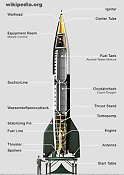 This
article by science fiction writer Arthur C. Clarke, of 2001: A Space Odyssey fame,
suggested the use of surplus German V−2 (Vergeltungswaffe 2; i.e., Retribution Weapon 2) rockets for launching
scientific payloads into space rather than for launching terrorizing attacks on
European cities. The October 1945 publishing date was after Germany had surrendered
in the spring of that year and Allied forces were rounding up war criminals and
confiscating documents and equipment. Clarke describes how an "artificial satellite"
could be caused to circle the earth "perpetually" and was published in the October
1945 edition of Wireless World magazine. The pilot-less V−2, along with
the V−1 "Buzz Bomb," were launched from within Germany and caused massive structural
damage and human death and suffering. For war progenitor and aggressor, Germany,
to call it a retribution weapon was a gross misnomer, especially considering it
was the second time (WWI and WWII) in three decades that the country had attempted
to bring Europe under its dominance with brutal assaults... This
article by science fiction writer Arthur C. Clarke, of 2001: A Space Odyssey fame,
suggested the use of surplus German V−2 (Vergeltungswaffe 2; i.e., Retribution Weapon 2) rockets for launching
scientific payloads into space rather than for launching terrorizing attacks on
European cities. The October 1945 publishing date was after Germany had surrendered
in the spring of that year and Allied forces were rounding up war criminals and
confiscating documents and equipment. Clarke describes how an "artificial satellite"
could be caused to circle the earth "perpetually" and was published in the October
1945 edition of Wireless World magazine. The pilot-less V−2, along with
the V−1 "Buzz Bomb," were launched from within Germany and caused massive structural
damage and human death and suffering. For war progenitor and aggressor, Germany,
to call it a retribution weapon was a gross misnomer, especially considering it
was the second time (WWI and WWII) in three decades that the country had attempted
to bring Europe under its dominance with brutal assaults...
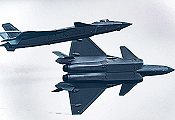 "A new-generation
plasma stealth device that can make almost any military aircraft vanish from a radar
screen is claimed to have been developed by a team of scientists and engineers from
western China. Unlike its predecessors, which generate a cloud of plasma draped
over a plane, this innovation can be tailored to fit a sensitive section of a military
aircraft - areas like the radar dome, cockpit or other spots that are most prone
to enemy radar detection. This 'closed electron beam plasma stealth device,' which focuses on
protecting key areas instead of the entire aircraft, can be switched on at a moment's
notice to fool radar operators. It has many advantages such as 'simple structure,
wide power adjustable range and high plasma density,' Tan Chang, a scientist involved
in the project, wrote in a peer-reviewed paper published in the Chinese Journal
of Radio Science in December. Chinese scientists say they can use foreign military
radar to track ships. Plasma, composed of electrically charged particles, interacts
with electromagnetic waves in a unique way. When electromagnetic waves - such as
those emitted by radar - interact with plasma, they cause the particles to move
rapidly and collide, dissipating the waves' energy and reducing the strength of
the reflected signal. This interaction converts the energy of the electromagnetic
waves into mechanical and thermal energy of the charged particles, diminishing the
waves' strength and subsequently weakening the radar signal reflected back. The
concept of plasma stealth technology traces back to the Cold War era, where both
the United States and the Soviet Union poured resources into its research and development.
However, due to technological constraints, it never progressed beyond the laboratory
phase... (line 546 in page source view for non-subscribers) "A new-generation
plasma stealth device that can make almost any military aircraft vanish from a radar
screen is claimed to have been developed by a team of scientists and engineers from
western China. Unlike its predecessors, which generate a cloud of plasma draped
over a plane, this innovation can be tailored to fit a sensitive section of a military
aircraft - areas like the radar dome, cockpit or other spots that are most prone
to enemy radar detection. This 'closed electron beam plasma stealth device,' which focuses on
protecting key areas instead of the entire aircraft, can be switched on at a moment's
notice to fool radar operators. It has many advantages such as 'simple structure,
wide power adjustable range and high plasma density,' Tan Chang, a scientist involved
in the project, wrote in a peer-reviewed paper published in the Chinese Journal
of Radio Science in December. Chinese scientists say they can use foreign military
radar to track ships. Plasma, composed of electrically charged particles, interacts
with electromagnetic waves in a unique way. When electromagnetic waves - such as
those emitted by radar - interact with plasma, they cause the particles to move
rapidly and collide, dissipating the waves' energy and reducing the strength of
the reflected signal. This interaction converts the energy of the electromagnetic
waves into mechanical and thermal energy of the charged particles, diminishing the
waves' strength and subsequently weakening the radar signal reflected back. The
concept of plasma stealth technology traces back to the Cold War era, where both
the United States and the Soviet Union poured resources into its research and development.
However, due to technological constraints, it never progressed beyond the laboratory
phase... (line 546 in page source view for non-subscribers)
 Airplanes and Rockets website visitor Boyd
Steffen sent me this photo of the formers he made using a 3D printer. People are
building entire flyable model airplanes using 3D printing, including detailed scale
airplanes, aerobatic and super fast models, lightweight Park Flyers, and training
types. The science/art has come a long way in the last decade. A YouTube search
on
3D printed model airplane will have you amazed at what is being
done, if you aren't already aware. The guys designing and building them have a very
impressive knowledge of what is needed to maximizing strength and rigidity while
maintaining minimal weight - no doubt as a result of trial and error... Airplanes and Rockets website visitor Boyd
Steffen sent me this photo of the formers he made using a 3D printer. People are
building entire flyable model airplanes using 3D printing, including detailed scale
airplanes, aerobatic and super fast models, lightweight Park Flyers, and training
types. The science/art has come a long way in the last decade. A YouTube search
on
3D printed model airplane will have you amazed at what is being
done, if you aren't already aware. The guys designing and building them have a very
impressive knowledge of what is needed to maximizing strength and rigidity while
maintaining minimal weight - no doubt as a result of trial and error...
 This 4-view drawing of the
Fairchild
22 C-7-F (1934) was scanned from page 38B and 38C of my purchased edition of
the July 1968 American Aircraft Modeler (AAM) magazine. It is another example
of Björn Karlström's fine scale drawings. In the pre-Internet days, this sort of
detailed documentation was harder to come by, so AAM provided a great service by
publishing these. Per Wikipedia: "The aircraft was designed by Kreider-Reisner during
negotiations by Sherman Fairchild to take a major share in the company. Marketed
as the Fairchild 22 Model C7 the aircraft was certified in March 1931. The Fairchild
22 was a mixed-construction braced parasol-wing monoplane with a fixed tailwheel
landing gear and a braced tail unit. It had two tandem open cockpits and was initially
powered by a 80hp (60kW) Armstrong Siddeley Genet radial engine. After test flying
the prototype the first production aircraft were re-engined with a 75hp (56kW) Michigan
Rover inverted inline engine. The aircraft was fitted with both inline and radial
piston engines... This 4-view drawing of the
Fairchild
22 C-7-F (1934) was scanned from page 38B and 38C of my purchased edition of
the July 1968 American Aircraft Modeler (AAM) magazine. It is another example
of Björn Karlström's fine scale drawings. In the pre-Internet days, this sort of
detailed documentation was harder to come by, so AAM provided a great service by
publishing these. Per Wikipedia: "The aircraft was designed by Kreider-Reisner during
negotiations by Sherman Fairchild to take a major share in the company. Marketed
as the Fairchild 22 Model C7 the aircraft was certified in March 1931. The Fairchild
22 was a mixed-construction braced parasol-wing monoplane with a fixed tailwheel
landing gear and a braced tail unit. It had two tandem open cockpits and was initially
powered by a 80hp (60kW) Armstrong Siddeley Genet radial engine. After test flying
the prototype the first production aircraft were re-engined with a 75hp (56kW) Michigan
Rover inverted inline engine. The aircraft was fitted with both inline and radial
piston engines...
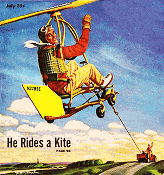 Many guys my age (65) remember seeing advertisements
back in the 1960s, 70s, and 80s for the
Bensen Gyrocopter in the pages of magazines like Mechanics
Illustrated, Popular Mechanix, Science and Mechanics, etc.
Bensen stopped kit production in 1988. This 1954 issue of Popular Science
magazine featured a story on Igor Bensen's early towed version of his gyrocopter
(model B−6), which he referred to as a gyro−glider. According to later published
information, the round tubing used here was replaced with square tubing due to difficulties
in building experienced by owners. Prior to opening Bensen Aircraft Company, Dr. Bensen
designed gyroplanes and related aircraft for General electric and Kaman. I never
had any hopes of being able to build a gyrocopter, but did hold out some hope for
maybe building one of the lawn mower engine powered hovercraft that also showed
up all the time. Alas, neither was ever done... Many guys my age (65) remember seeing advertisements
back in the 1960s, 70s, and 80s for the
Bensen Gyrocopter in the pages of magazines like Mechanics
Illustrated, Popular Mechanix, Science and Mechanics, etc.
Bensen stopped kit production in 1988. This 1954 issue of Popular Science
magazine featured a story on Igor Bensen's early towed version of his gyrocopter
(model B−6), which he referred to as a gyro−glider. According to later published
information, the round tubing used here was replaced with square tubing due to difficulties
in building experienced by owners. Prior to opening Bensen Aircraft Company, Dr. Bensen
designed gyroplanes and related aircraft for General electric and Kaman. I never
had any hopes of being able to build a gyrocopter, but did hold out some hope for
maybe building one of the lawn mower engine powered hovercraft that also showed
up all the time. Alas, neither was ever done...
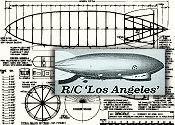 An Airplanes and Rockets visitor wrote requesting
that I post this article on the R/C Los Angeles airship, so here it is. There have
been a few articles in the last year or so reporting on
radio-controlled
blimps (airships, dirigibles, etc.). The advent of super-light radio gear, powerful
little brushless motors, and high energy density batteries has made them practical
in almost any scale. This "Los Angeles" model is 53" long and 11½" in diameter,
and will lift 8-10 ounces of gear. In 1968, when this article was published in
American Aircraft Modeler magazine, there was no lightweight film covering
material that was both strong enough and gas-tight enough to do the job, so thin
silk and butyrate dope were used. Modern covering and equipment should let this
baby fly to the moon... An Airplanes and Rockets visitor wrote requesting
that I post this article on the R/C Los Angeles airship, so here it is. There have
been a few articles in the last year or so reporting on
radio-controlled
blimps (airships, dirigibles, etc.). The advent of super-light radio gear, powerful
little brushless motors, and high energy density batteries has made them practical
in almost any scale. This "Los Angeles" model is 53" long and 11½" in diameter,
and will lift 8-10 ounces of gear. In 1968, when this article was published in
American Aircraft Modeler magazine, there was no lightweight film covering
material that was both strong enough and gas-tight enough to do the job, so thin
silk and butyrate dope were used. Modern covering and equipment should let this
baby fly to the moon...
 I, for one, do not fear
the emergence of artificial intelligence
(AI). The fact is we have been living through an evolutionary process in AI since
the beginning of the computer age - it just wasn't called AI at the time. Electronic
and mechanical CAD/CAE software with optimization routines are AI. PCB layout autorouting
is AI. Weather prediction algorithms are AI. MRI and x-ray images processing is
AI, as is tax preparation software. I'd say "get used to it," but you already have.
This Sora project by
OpenAI (the
ChatGPT folks) is basically a real-life rendition version of what
Pixar is for cartoon
animation. "We're teaching AI to understand and simulate the physical world in motion,
with the goal of training models that help people solve problems that require real-world
interaction. Sora can generate videos up to a minute long while maintaining visual
quality and adherence to the user's prompt. Sora is able to generate complex scenes
with multiple characters, specific types of motion, and accurate details of the
subject and background. The model understands not only what the user has asked for
in the prompt, but also how those things exist in the physical world. The current
model has weaknesses. For example, a person might take a bite out of a cookie, but
afterward, the cookie may not have a bite mark..." The movie industry is crying
foul, but honestly, would many people care if the egotistical, largely ignorant,
bloviating Hollywood actors went away? I, for one, do not fear
the emergence of artificial intelligence
(AI). The fact is we have been living through an evolutionary process in AI since
the beginning of the computer age - it just wasn't called AI at the time. Electronic
and mechanical CAD/CAE software with optimization routines are AI. PCB layout autorouting
is AI. Weather prediction algorithms are AI. MRI and x-ray images processing is
AI, as is tax preparation software. I'd say "get used to it," but you already have.
This Sora project by
OpenAI (the
ChatGPT folks) is basically a real-life rendition version of what
Pixar is for cartoon
animation. "We're teaching AI to understand and simulate the physical world in motion,
with the goal of training models that help people solve problems that require real-world
interaction. Sora can generate videos up to a minute long while maintaining visual
quality and adherence to the user's prompt. Sora is able to generate complex scenes
with multiple characters, specific types of motion, and accurate details of the
subject and background. The model understands not only what the user has asked for
in the prompt, but also how those things exist in the physical world. The current
model has weaknesses. For example, a person might take a bite out of a cookie, but
afterward, the cookie may not have a bite mark..." The movie industry is crying
foul, but honestly, would many people care if the egotistical, largely ignorant,
bloviating Hollywood actors went away?
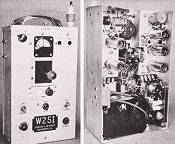 When I wax nostalgic about old
tube radio
sets, it is not because I don't appreciate the performance and quality of modern
electronics. It is just that a lot of the technology was still mainstream when I
was young (born in 1958). I remember having it in my parents' house and seeing even
older stuff in my grandparents' house. Some people's midlife crisis takes the form
of wearing age-inappropriate clothing, gold jewelry, and chasing after strange women.
The manifestation of my "crisis," if you want to call it that, has been collecting
memorabilia from days of yore. There is a huge demand for it, so I make as much
as I have time for posting available for others to enjoy. Articles like this one
are from old editions I bought on eBay, a 1963 edition of American Modeler
magazine in this instance. Even though nobody will go out and buy parts to build
this tube-based R/C transmitter, there are useful descriptions of circuit design
considerations, including the use of a center-loaded, half-wave antenna. Hams eat
this stuff up... When I wax nostalgic about old
tube radio
sets, it is not because I don't appreciate the performance and quality of modern
electronics. It is just that a lot of the technology was still mainstream when I
was young (born in 1958). I remember having it in my parents' house and seeing even
older stuff in my grandparents' house. Some people's midlife crisis takes the form
of wearing age-inappropriate clothing, gold jewelry, and chasing after strange women.
The manifestation of my "crisis," if you want to call it that, has been collecting
memorabilia from days of yore. There is a huge demand for it, so I make as much
as I have time for posting available for others to enjoy. Articles like this one
are from old editions I bought on eBay, a 1963 edition of American Modeler
magazine in this instance. Even though nobody will go out and buy parts to build
this tube-based R/C transmitter, there are useful descriptions of circuit design
considerations, including the use of a center-loaded, half-wave antenna. Hams eat
this stuff up...
 This is a rare find. After having a Saved
Search on eBay for years, looking for an
O.S.
Digitron DP-3, 3-Channel Radio Control System with original packaging and documentation,
one finally came up for sale. It was listed with inexact wording in the title, so
maybe that's why I found it before others. It had only been listed for a few minutes,
and I bought it instantly. This has got to be one of the primo examples left in
the world. All the original packaging and documentation is here, even including
a set of O.S. Digital decals. Why the enthusiasm, you might ask? This was my
very first R/C system that I bought from a neighbor for $100, back in 1974, when
I was a mere 15 or 16 years old. To my best recollection, it came with everything
here. The fitted leather transmitter case was very nice, and it kept the metal chassis
in excellent condition. My radio was on 27.195 MHz (green flag), and at the
time, an FCC license was required to operate it... This is a rare find. After having a Saved
Search on eBay for years, looking for an
O.S.
Digitron DP-3, 3-Channel Radio Control System with original packaging and documentation,
one finally came up for sale. It was listed with inexact wording in the title, so
maybe that's why I found it before others. It had only been listed for a few minutes,
and I bought it instantly. This has got to be one of the primo examples left in
the world. All the original packaging and documentation is here, even including
a set of O.S. Digital decals. Why the enthusiasm, you might ask? This was my
very first R/C system that I bought from a neighbor for $100, back in 1974, when
I was a mere 15 or 16 years old. To my best recollection, it came with everything
here. The fitted leather transmitter case was very nice, and it kept the metal chassis
in excellent condition. My radio was on 27.195 MHz (green flag), and at the
time, an FCC license was required to operate it...
 It's hard to imagine a time when radio control
was such a novelty that contests included events where models were steered around
on the ground to weave through obstacles, as was the case when this 1957 American
Modeler magazine article was published. The thing is, when I got my first R/C
system, an OS Digital 3−channel set, I had not yet learned to fly so I "drove" my
S−Ray around the yard and in the street in front of my house. The noise from the
OS .20 engine and the RF interference on television VHF channel 5 annoyed the neighbors
at times. My transmitter was at 27.195 MHz, and the harmonics fell squarely
into the RF and audio bands. My best friend back in the day had one of the Smog
Hogs referred to in the article. In 1957,
radio systems only approximated proportional control, so smooth
maneuvers were not easy to do. Receiver tuning was necessary between flights for
a lot of systems, and interference from other users in or near the 27 MHz band
was a constant threat to models... It's hard to imagine a time when radio control
was such a novelty that contests included events where models were steered around
on the ground to weave through obstacles, as was the case when this 1957 American
Modeler magazine article was published. The thing is, when I got my first R/C
system, an OS Digital 3−channel set, I had not yet learned to fly so I "drove" my
S−Ray around the yard and in the street in front of my house. The noise from the
OS .20 engine and the RF interference on television VHF channel 5 annoyed the neighbors
at times. My transmitter was at 27.195 MHz, and the harmonics fell squarely
into the RF and audio bands. My best friend back in the day had one of the Smog
Hogs referred to in the article. In 1957,
radio systems only approximated proportional control, so smooth
maneuvers were not easy to do. Receiver tuning was necessary between flights for
a lot of systems, and interference from other users in or near the 27 MHz band
was a constant threat to models...
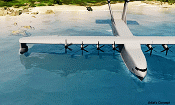 "Aurora Flight Sciences said it is progressing
through Phase 1B of the project, a Defense Advanced Research Projects Agency (DARPA)
program to design, build, float, and fly the aircraft. To meet
heavy-air-lift capability from the sea the vehicle will operate
efficiently in ground effect at high sea states and demonstrate affordability using
low-cost manufacturing and unique design features. Virginia-headquartered Aurora
Flight Sciences added that a major focus during Phase 1B is testing for risk reduction.
ReconCraft, an Oregon-based shipyard, will build full-scale structural test articles,
including a portion of the fuselage. The Aurora team also tested a scale model of
the hull in the tow tank at Virginia Tech, which offers a unique capability to study
the slamming of craft during landing. Upcoming testing includes flying sensors and
software for wave detection and prediction, which will feed the X-plane's advanced
control system for safely flying in ground effect over high sea states..." "Aurora Flight Sciences said it is progressing
through Phase 1B of the project, a Defense Advanced Research Projects Agency (DARPA)
program to design, build, float, and fly the aircraft. To meet
heavy-air-lift capability from the sea the vehicle will operate
efficiently in ground effect at high sea states and demonstrate affordability using
low-cost manufacturing and unique design features. Virginia-headquartered Aurora
Flight Sciences added that a major focus during Phase 1B is testing for risk reduction.
ReconCraft, an Oregon-based shipyard, will build full-scale structural test articles,
including a portion of the fuselage. The Aurora team also tested a scale model of
the hull in the tow tank at Virginia Tech, which offers a unique capability to study
the slamming of craft during landing. Upcoming testing includes flying sensors and
software for wave detection and prediction, which will feed the X-plane's advanced
control system for safely flying in ground effect over high sea states..."
 World War II had only been over three
years when the U.S. Navy began
jet fighter operations from aircraft carriers. Angled decks had
not even entered service when the North American FJ-1 Fury jet fighters made the
first takeoffs and landing on the straight−deck USS Boxer. The USS Forrestal, our
first angled deck carrier, was commissioned in 1951. This story appeared in a 1948
issue of Popular Science magazine. Note the huge clock on deck which was
photographed upon being triggered by the airplane hooking an arrestor line, so that
a precise lending time would be recorded. The way the picture is taken, it looks
like a perspective trick to make a small clock look much larger than it actually
was. I like the fact that Lt. Comdr. Robert Elder took a wave−off on a first approach
in order to give his skipper, Comdr. Evan (Pete) Aurand the honor of the first−ever
jet aircraft landing at sea. Nowadays, computers routinely fly jet−powered drones
off of and onto carrier decks... World War II had only been over three
years when the U.S. Navy began
jet fighter operations from aircraft carriers. Angled decks had
not even entered service when the North American FJ-1 Fury jet fighters made the
first takeoffs and landing on the straight−deck USS Boxer. The USS Forrestal, our
first angled deck carrier, was commissioned in 1951. This story appeared in a 1948
issue of Popular Science magazine. Note the huge clock on deck which was
photographed upon being triggered by the airplane hooking an arrestor line, so that
a precise lending time would be recorded. The way the picture is taken, it looks
like a perspective trick to make a small clock look much larger than it actually
was. I like the fact that Lt. Comdr. Robert Elder took a wave−off on a first approach
in order to give his skipper, Comdr. Evan (Pete) Aurand the honor of the first−ever
jet aircraft landing at sea. Nowadays, computers routinely fly jet−powered drones
off of and onto carrier decks...
 Here is Melanie with her gaf
View−Master "Tour Theatre" set that she had as a little girl.
She took better care of her stuff than I did, so a lot of her toys and dolls are
still around decades later. It came with a Standard 30−watt projector and a hand−held
stereo viewer. Also included was a nice case and a few reel sets with various places
around the world*. Being a Peanuts fan like me, she had a couple 3−reel sets: "Snoopy
and the Red Baron," and Peanuts." We have a "Little Drummer Boy" and "Dennis the
Menace" set, too. The others are long gone. I had just a hand−held viewer. See my
space program reel sets. The hand−held View−Master viewer that created a 3D scene
by using a pair of stereoscopic images fed individually to each eye. One of the
Peanuts reels has a frame showing how those stereoscopic images were created using
two cameras set up a distance apart so that each had a slightly different perspective
on the subject, just as your eyes have. There are 14 frames in each reel, so using
two frames per 3D scene, that makes 7 scenes per reel. Replacement 7-14-scene reel
selector lever installed on mechanism. Home-brew 7-14-scene reel selector lever.
6-32 bolt is soldered to steel lever, and then the head ground down to provide needed
clearance. 7-14-scene reel selector mechanism. Side view of projector reel advance
mechanism. Westinghouse RVR115, 120V, 30W light bulb for View−Master Standard projector.
The projector, on the other hand, cannot create a 3D image on the screen (or wall).
Therefore, a standard 3D reel only has 7 unique scenes on it. Special reels were
sold for the projector that had 14 unique scenes on it. As such, the projector designers
provided a lever to be positioned for either a 7-scene or a 14-scene reel. We discovered
that the lever was missing... Here is Melanie with her gaf
View−Master "Tour Theatre" set that she had as a little girl.
She took better care of her stuff than I did, so a lot of her toys and dolls are
still around decades later. It came with a Standard 30−watt projector and a hand−held
stereo viewer. Also included was a nice case and a few reel sets with various places
around the world*. Being a Peanuts fan like me, she had a couple 3−reel sets: "Snoopy
and the Red Baron," and Peanuts." We have a "Little Drummer Boy" and "Dennis the
Menace" set, too. The others are long gone. I had just a hand−held viewer. See my
space program reel sets. The hand−held View−Master viewer that created a 3D scene
by using a pair of stereoscopic images fed individually to each eye. One of the
Peanuts reels has a frame showing how those stereoscopic images were created using
two cameras set up a distance apart so that each had a slightly different perspective
on the subject, just as your eyes have. There are 14 frames in each reel, so using
two frames per 3D scene, that makes 7 scenes per reel. Replacement 7-14-scene reel
selector lever installed on mechanism. Home-brew 7-14-scene reel selector lever.
6-32 bolt is soldered to steel lever, and then the head ground down to provide needed
clearance. 7-14-scene reel selector mechanism. Side view of projector reel advance
mechanism. Westinghouse RVR115, 120V, 30W light bulb for View−Master Standard projector.
The projector, on the other hand, cannot create a 3D image on the screen (or wall).
Therefore, a standard 3D reel only has 7 unique scenes on it. Special reels were
sold for the projector that had 14 unique scenes on it. As such, the projector designers
provided a lever to be positioned for either a 7-scene or a 14-scene reel. We discovered
that the lever was missing...
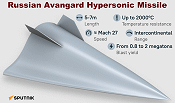 A
lot has been in the news recently about Russia's new
hypersonic glide vehicle capable of delivering nuclear (and conventional)
warheads across the globe at over than Mach 20 (14,822 mph) in the atmosphere.
That's 4.1 miles per second. From a 150 mile high apogee, that's less than 40 seconds
from space to target. Not even a high power laser can stop that. The
great circle path from Siberia to San Francisco is 5,900 miles,
for a flight time of less than a minute after launch phase. Moscow to D.C., (4,900
miles) takes a little less
time. Here is a recent interview with Putin on Russia's state of the union regarding social,
economic, and military issues - including hypersonic weapons. Oh, and they're not
fixing their low birth rate by importing felons, psycho patients and
cannibals from the third World. Interestingly, he addresses the
rampant embezzlement schemes that U.S. defense contractors and their management
perpetrate. Sure, a lot is propaganda, but so is what comes out of Washington. A
lot has been in the news recently about Russia's new
hypersonic glide vehicle capable of delivering nuclear (and conventional)
warheads across the globe at over than Mach 20 (14,822 mph) in the atmosphere.
That's 4.1 miles per second. From a 150 mile high apogee, that's less than 40 seconds
from space to target. Not even a high power laser can stop that. The
great circle path from Siberia to San Francisco is 5,900 miles,
for a flight time of less than a minute after launch phase. Moscow to D.C., (4,900
miles) takes a little less
time. Here is a recent interview with Putin on Russia's state of the union regarding social,
economic, and military issues - including hypersonic weapons. Oh, and they're not
fixing their low birth rate by importing felons, psycho patients and
cannibals from the third World. Interestingly, he addresses the
rampant embezzlement schemes that U.S. defense contractors and their management
perpetrate. Sure, a lot is propaganda, but so is what comes out of Washington.
 $25 R/C helicopters are available from Amazon
that climb and turn on demand (kinda). For under $60 you get a fully controllable
model with counter-rotating rotors that anyone can fly like a pro in after an hour
or two of practice. Double that amount and a 3-D-capable, ready-to-fly helicopter
is available to you, complete with a spread spectrum radio, gyro stabilization,
a brushless motor, and Li-Poly batteries... with a computerized charger. Engineers
have labored endlessly to bring this state of the art technology to all corners
of the world. It was not that way all so long ago. To wit, take a look at this article
from the March 1969 edition of American Aircraft Modeler magazine, that
reported on Germany's first ever R/C helicopter competition that was held
in the fall of 1968. There were no kits (let alone RFTs), no special heli engines,
no gyroscopes, no carbon fiber blades, to "how-to" manuals, not even any reserved
frequencies for the newly arrived proportional radio control systems. All helicopters
there were designed and built from scratch, and no two looked alike; large number
or unique color schemes were not necessary to keep track of a cookie-cutter production
craft... $25 R/C helicopters are available from Amazon
that climb and turn on demand (kinda). For under $60 you get a fully controllable
model with counter-rotating rotors that anyone can fly like a pro in after an hour
or two of practice. Double that amount and a 3-D-capable, ready-to-fly helicopter
is available to you, complete with a spread spectrum radio, gyro stabilization,
a brushless motor, and Li-Poly batteries... with a computerized charger. Engineers
have labored endlessly to bring this state of the art technology to all corners
of the world. It was not that way all so long ago. To wit, take a look at this article
from the March 1969 edition of American Aircraft Modeler magazine, that
reported on Germany's first ever R/C helicopter competition that was held
in the fall of 1968. There were no kits (let alone RFTs), no special heli engines,
no gyroscopes, no carbon fiber blades, to "how-to" manuals, not even any reserved
frequencies for the newly arrived proportional radio control systems. All helicopters
there were designed and built from scratch, and no two looked alike; large number
or unique color schemes were not necessary to keep track of a cookie-cutter production
craft...
 With the entry of the United States into
World War II came the need for service members to be trained on many new technologies
- among them being airplanes and the ability to identify them quickly. Electronics
technicians and airframe and powerplant mechanics were in need, of course, but everyone
had to be able to tell friend from foe when airplanes were approaching. In order
to assist the war effort, a call went out to civilians to begin producing thousands
of
models at a 1:72 scale so that at 35 feet away they appeared in
size to be that of a full-scale version at about half a mile. Detailed paint jobs
were not required - only that the profile from all angles look exactly like the
real thing. In fact, the models were painted flat black so as to look like a distant
airplane against the background sky. Both Allied and Axis airplane models were needed
so that soldiers and sailors could quickly spot a potential danger and decide whether
to take cover and prepare to fight, or to continue with business as usual. This
article appeared in the May 1942 edition of Popular Science, meaning that it was
probably written sometime around February, only a few months after the Japanese
attacked our naval base at Pearl Harbor, Hawaii, on December 7, 1941... With the entry of the United States into
World War II came the need for service members to be trained on many new technologies
- among them being airplanes and the ability to identify them quickly. Electronics
technicians and airframe and powerplant mechanics were in need, of course, but everyone
had to be able to tell friend from foe when airplanes were approaching. In order
to assist the war effort, a call went out to civilians to begin producing thousands
of
models at a 1:72 scale so that at 35 feet away they appeared in
size to be that of a full-scale version at about half a mile. Detailed paint jobs
were not required - only that the profile from all angles look exactly like the
real thing. In fact, the models were painted flat black so as to look like a distant
airplane against the background sky. Both Allied and Axis airplane models were needed
so that soldiers and sailors could quickly spot a potential danger and decide whether
to take cover and prepare to fight, or to continue with business as usual. This
article appeared in the May 1942 edition of Popular Science, meaning that it was
probably written sometime around February, only a few months after the Japanese
attacked our naval base at Pearl Harbor, Hawaii, on December 7, 1941...
 It's a good bet that many modelers, myself
included, have dreamed about
owning a hobby shop. How nice it would be to spend our days amongst
walls, shelves, and display cases filled with every type of modeling kit and accessory.
Melanie and I actually looked into buying one when we lived in Colorado Springs
in the early 1990s. It's a good thing we didn't in retrospect, given the way the
local hobby shop (LHS) has suffered tremendously since Internet-based purchases
have become so popular - especially being tax-free in most areas. There are still
big hobby shops left, but they are few and far between. I'm as guilty as the next
guy for not doing more to support my LHS, but usually it's for convenience sake
more so than price and not paying sales tax. This article from the November 1962
edition of American Modeler magazine, a time when local hobby shops were
still the rule rather than the exception, is a humorous "day in the life of a hobby
dealer." You can just imagine how plausible the scenario might be... It's a good bet that many modelers, myself
included, have dreamed about
owning a hobby shop. How nice it would be to spend our days amongst
walls, shelves, and display cases filled with every type of modeling kit and accessory.
Melanie and I actually looked into buying one when we lived in Colorado Springs
in the early 1990s. It's a good thing we didn't in retrospect, given the way the
local hobby shop (LHS) has suffered tremendously since Internet-based purchases
have become so popular - especially being tax-free in most areas. There are still
big hobby shops left, but they are few and far between. I'm as guilty as the next
guy for not doing more to support my LHS, but usually it's for convenience sake
more so than price and not paying sales tax. This article from the November 1962
edition of American Modeler magazine, a time when local hobby shops were
still the rule rather than the exception, is a humorous "day in the life of a hobby
dealer." You can just imagine how plausible the scenario might be...
 Chuck Yeager broke the sound barrier in
his Bell X−1 (aka Glamorous Glennis) airplane on October 14, 1947, over the Mojave
Desert.
Control reversal in the transonic realm (transitioning from subsonic
to supersonic speeds) is a phenomenon caused, per most authoritative sources, from
the pressure wavefront around the aircraft transitioning from entirely in front
of the airplane to some point aft of any leading portion of the airframe. That includes
the fuselage nose, and wings and empennage leading edges. Airflow can transition
from laminar to turbulent at various distances, thereby altering the aerodynamic
forces on the fixed and moving portions of the surfaces. Control reversal can also
occur due to control surface deflection causing a twist in the fixed surface which
opposes the input intention. Britain's Spitfire exhibited such behavior in high
speed dives, and even the human-powered Gossamer Condor reportedly had control reversal
due to a flimsy airframe structure to the extent that the solution was to reverse
the direction of aileron deflection in order to obtain a proper response. Supersonic
airframes are rigid enough to mitigate the flexure problem... Chuck Yeager broke the sound barrier in
his Bell X−1 (aka Glamorous Glennis) airplane on October 14, 1947, over the Mojave
Desert.
Control reversal in the transonic realm (transitioning from subsonic
to supersonic speeds) is a phenomenon caused, per most authoritative sources, from
the pressure wavefront around the aircraft transitioning from entirely in front
of the airplane to some point aft of any leading portion of the airframe. That includes
the fuselage nose, and wings and empennage leading edges. Airflow can transition
from laminar to turbulent at various distances, thereby altering the aerodynamic
forces on the fixed and moving portions of the surfaces. Control reversal can also
occur due to control surface deflection causing a twist in the fixed surface which
opposes the input intention. Britain's Spitfire exhibited such behavior in high
speed dives, and even the human-powered Gossamer Condor reportedly had control reversal
due to a flimsy airframe structure to the extent that the solution was to reverse
the direction of aileron deflection in order to obtain a proper response. Supersonic
airframes are rigid enough to mitigate the flexure problem...
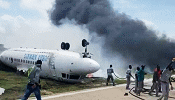 "Statista's Martin Armstrong reports that
data from the airline umbrella organization IATA shows that 53% of all aviation
accidents that occurred between 2005 and 2023
happened during the landing process. Landing is a complex process
during which pilots have to keep a particularly close eye on instruments, radio
traffic and environmental influences. Accidents during takeoff are in second place,
although they only account for 8.5% of accidents. This is followed by accidents
during the landing approach, during the initial climb or during the cruise flight.
The data relates to flights operated by IATA members, which together account for
around 94% of all international flights. Despite the increasing volume of headlines,
aviation has, overall, become increasingly safer in recent decades. In 2022, for
example, only 43 accidents occurred out of 27.7 million flights, resulting in the
deaths of 158 people. Most air accidents take place in Africa, South America and
the Middle East. After North Asia and North America, Europe is one of the safest
regions with the fewest accidents..." "Statista's Martin Armstrong reports that
data from the airline umbrella organization IATA shows that 53% of all aviation
accidents that occurred between 2005 and 2023
happened during the landing process. Landing is a complex process
during which pilots have to keep a particularly close eye on instruments, radio
traffic and environmental influences. Accidents during takeoff are in second place,
although they only account for 8.5% of accidents. This is followed by accidents
during the landing approach, during the initial climb or during the cruise flight.
The data relates to flights operated by IATA members, which together account for
around 94% of all international flights. Despite the increasing volume of headlines,
aviation has, overall, become increasingly safer in recent decades. In 2022, for
example, only 43 accidents occurred out of 27.7 million flights, resulting in the
deaths of 158 people. Most air accidents take place in Africa, South America and
the Middle East. After North Asia and North America, Europe is one of the safest
regions with the fewest accidents..."
 A Christmas Story has long been
one of my favorite Christmas movies.
A Charlie Brown Christmas is my favorite
animated movie, and It's a Wonderful Life gets the #1 spot for a film,
but this runs a very close second. It first aired around Christmas of 1983, so I
was 25 at the time - a bit old for Christmas movies you might say... but you'd be
wrong. Every year between Thanksgiving and Christmas, Melanie and I watch those
three movies, plus Rudolph the Red Nosed Reindeer, How the Grinch Stole
Christmas, and A Christmas Carol (the original with Alastair Sim).
A Christmas Story was adopted from a story that Jean Shepherd read on his
radio show on WOR, in New York, on December 25, 1972. A friend of mine who lived
there at the time happened to record the original broadcast on his reel-to-reel
tape deck, and a couple years ago he sent me a copy on CD. The movie, of course,
expounds on the story, but in this case it adds a lot. Jean Shepard narrates in
the background of the movie as Ralphie remembering his childhood... A Christmas Story has long been
one of my favorite Christmas movies.
A Charlie Brown Christmas is my favorite
animated movie, and It's a Wonderful Life gets the #1 spot for a film,
but this runs a very close second. It first aired around Christmas of 1983, so I
was 25 at the time - a bit old for Christmas movies you might say... but you'd be
wrong. Every year between Thanksgiving and Christmas, Melanie and I watch those
three movies, plus Rudolph the Red Nosed Reindeer, How the Grinch Stole
Christmas, and A Christmas Carol (the original with Alastair Sim).
A Christmas Story was adopted from a story that Jean Shepherd read on his
radio show on WOR, in New York, on December 25, 1972. A friend of mine who lived
there at the time happened to record the original broadcast on his reel-to-reel
tape deck, and a couple years ago he sent me a copy on CD. The movie, of course,
expounds on the story, but in this case it adds a lot. Jean Shepard narrates in
the background of the movie as Ralphie remembering his childhood...
 The
Thermal-G R/C Club
held its annual summer fly-in on August 15, 2010, at the Erie Tech Center. The day
was sunny (a little too warm for me) and quite windy. Because of the wind, most
models were grounded, but a few brave souls did some flying, including quite a bit
of 3-D stuff. I always get nervous seeing that stuff done so close to the pit area
- especially in high wind - but at least up to the point that Melanie and I left,
there had been no incidents. Also present were members of the Bean Hill Flyers control
line club. Here are a few pictures I took of the flight line... The
Thermal-G R/C Club
held its annual summer fly-in on August 15, 2010, at the Erie Tech Center. The day
was sunny (a little too warm for me) and quite windy. Because of the wind, most
models were grounded, but a few brave souls did some flying, including quite a bit
of 3-D stuff. I always get nervous seeing that stuff done so close to the pit area
- especially in high wind - but at least up to the point that Melanie and I left,
there had been no incidents. Also present were members of the Bean Hill Flyers control
line club. Here are a few pictures I took of the flight line...
 This "Test Your Knowledge" feature appeared
in the March 1967 issue of American Modeler magazine, immediately following
the "Wanted:
A & P Mechanics - Part II" article (I do not yet have
Part I). Way back in my younger day during the time I was taking flying lessons
and thought a career in flying was the only reasonable path for me, I planned to
earn a Airframe & Powerplant (A&P) license. Destiny had other plans, since
when I signed up for the Delayed Enlistment program with the U.S. Air Force, no
aircraft engine mechanic positions were open, and I ended up in electronics, working
on air traffic control radar maintenance (fixing and aligning, not as an air traffic
controller). As you can see from the test, a masterful grasp on the theory of engine
operation and maintenance was (and still is) required. Back in those days,
only the most qualified people were selected to do the job - lives and fortunes
depended on it. Today, one of the biggest advantages you can have for getting an
aircraft mechanic job is not being a white male of European descent... This "Test Your Knowledge" feature appeared
in the March 1967 issue of American Modeler magazine, immediately following
the "Wanted:
A & P Mechanics - Part II" article (I do not yet have
Part I). Way back in my younger day during the time I was taking flying lessons
and thought a career in flying was the only reasonable path for me, I planned to
earn a Airframe & Powerplant (A&P) license. Destiny had other plans, since
when I signed up for the Delayed Enlistment program with the U.S. Air Force, no
aircraft engine mechanic positions were open, and I ended up in electronics, working
on air traffic control radar maintenance (fixing and aligning, not as an air traffic
controller). As you can see from the test, a masterful grasp on the theory of engine
operation and maintenance was (and still is) required. Back in those days,
only the most qualified people were selected to do the job - lives and fortunes
depended on it. Today, one of the biggest advantages you can have for getting an
aircraft mechanic job is not being a white male of European descent...
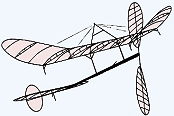 Even though I have never attempted to build
a
model covered with microfilm, it is easy to appreciate what a
delicate task properly preparing the solution, covering the frame, and handling
the delicate airframe is, along with the precision handling required to obtain the
correct film thickness and coverage. There have probably been improvements in microfilm
solutions and airframe materials and gluing techniques, but ultimately you need
to form the film on the wing, tail, and propeller surfaces. This 1971 American Aircraft
Modeler magazine article should still be useful for contemporary indoor flyers... Even though I have never attempted to build
a
model covered with microfilm, it is easy to appreciate what a
delicate task properly preparing the solution, covering the frame, and handling
the delicate airframe is, along with the precision handling required to obtain the
correct film thickness and coverage. There have probably been improvements in microfilm
solutions and airframe materials and gluing techniques, but ultimately you need
to form the film on the wing, tail, and propeller surfaces. This 1971 American Aircraft
Modeler magazine article should still be useful for contemporary indoor flyers...
 Ever since the manned space exploration
programs began at NASA (National Aeronautics and Space Administration), controversy
over both the financial costs and the cost in lost opportunity for other government
funded programs has existed. Many people, myself included, have always championed
the efforts and believe the axiom of the whole being greater than the sum of the
parts applies to the efforts. Opponents say resources would be better spent here
on Earth. In fact, we have always done both. To address the issue,
NASA
Spinoff was created to publicize the byproducts of the space program that benefit
other areas of research, manufacturing, and society. Since at least the 1970s, NASA
has published a monthly magazine entitled
NASA Tech
Briefs to inform the public on their activities, inviting readers to submit
ideas and to request information on how to apply NASA research to commercial applications.
I have been a regular reader since around 1980... Ever since the manned space exploration
programs began at NASA (National Aeronautics and Space Administration), controversy
over both the financial costs and the cost in lost opportunity for other government
funded programs has existed. Many people, myself included, have always championed
the efforts and believe the axiom of the whole being greater than the sum of the
parts applies to the efforts. Opponents say resources would be better spent here
on Earth. In fact, we have always done both. To address the issue,
NASA
Spinoff was created to publicize the byproducts of the space program that benefit
other areas of research, manufacturing, and society. Since at least the 1970s, NASA
has published a monthly magazine entitled
NASA Tech
Briefs to inform the public on their activities, inviting readers to submit
ideas and to request information on how to apply NASA research to commercial applications.
I have been a regular reader since around 1980...
 Just before Christmas 2015, Melanie and
I made a trip to Jamestown, New York, and visited
Lucile
M. Wright Air Museum (no relation to Wilbur and Orville). Is it located in downtown
Jamestown at 300 North Main Street. There are plenty of areas with unmetered parking,
so save yourself a couple quarters by driving a block or two to find it. Admission
is free. "Lucile Miller Wright was a pioneer aviatrix. She was born in Beatrice,
Nebraska and grew up in Billings, Montana. She discovered her love of flying as
a young woman. In 1922 she went on her first flight with General Billy Mitchell,
who was a personal friend of her father, Henry A. Miller. Mrs. Wright continually
battled discrimination in pursuit of her passion...Throughout her career, Mrs. Wright
logged 8,000 hours of flying time in the seven planes she owned and 5,000,000 miles
in commercial aircraft. During World War II, she was the only woman courier plot
in Western New York under the Civil Air Patrol Program..." Just before Christmas 2015, Melanie and
I made a trip to Jamestown, New York, and visited
Lucile
M. Wright Air Museum (no relation to Wilbur and Orville). Is it located in downtown
Jamestown at 300 North Main Street. There are plenty of areas with unmetered parking,
so save yourself a couple quarters by driving a block or two to find it. Admission
is free. "Lucile Miller Wright was a pioneer aviatrix. She was born in Beatrice,
Nebraska and grew up in Billings, Montana. She discovered her love of flying as
a young woman. In 1922 she went on her first flight with General Billy Mitchell,
who was a personal friend of her father, Henry A. Miller. Mrs. Wright continually
battled discrimination in pursuit of her passion...Throughout her career, Mrs. Wright
logged 8,000 hours of flying time in the seven planes she owned and 5,000,000 miles
in commercial aircraft. During World War II, she was the only woman courier plot
in Western New York under the Civil Air Patrol Program..."
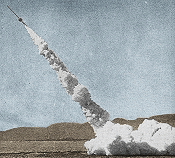 Is that Vern Estes in that foxhole preparing
to push the launch button? Probably not, but the materials and methods used here
in this 1948 issue of Popular Science magazine by amateur rocketeers are a big part
of the motivation Mr. Estes had for starting his eponymously named model rocket
company in 1958. To wit: "Rocket is driven by 35 pounds of micro grain powder, mostly
zinc dust and sulphur, which burns out in four seconds. It climbs to 4,000 feet
and reaches speed of more than 400 m.p.h." Handling the explosive and sometimes
unstable chemicals required for the rocket engines was extremely dangerous, and
resulted in many instances of loss of fingers and eyes, severe burns, and even death.
The safety record of Estes engines is borne out by more than sixty years of continuous
production. If they were not nearly perfectly safe, lawyers would have put Estes
out of business long ago. Even Olympic level stupid has not produced an event capable
that anything other than the user's idiocy was responsible for an engine-related
accident. Is that Vern Estes in that foxhole preparing
to push the launch button? Probably not, but the materials and methods used here
in this 1948 issue of Popular Science magazine by amateur rocketeers are a big part
of the motivation Mr. Estes had for starting his eponymously named model rocket
company in 1958. To wit: "Rocket is driven by 35 pounds of micro grain powder, mostly
zinc dust and sulphur, which burns out in four seconds. It climbs to 4,000 feet
and reaches speed of more than 400 m.p.h." Handling the explosive and sometimes
unstable chemicals required for the rocket engines was extremely dangerous, and
resulted in many instances of loss of fingers and eyes, severe burns, and even death.
The safety record of Estes engines is borne out by more than sixty years of continuous
production. If they were not nearly perfectly safe, lawyers would have put Estes
out of business long ago. Even Olympic level stupid has not produced an event capable
that anything other than the user's idiocy was responsible for an engine-related
accident.
 Website visitor Alan M. wrote to request
that I scan this Dancer article from the February 1971 edition of American Aircraft
Modeler magazine. The
Dancer is a beginner's level control line trainer model for 1/2A
power that is one of the many "For the Tenderfoot" series. Construction is all simple
sheet balsa. Even back in the early 1970s millions of Cox .049 engines had already
been produced, so they were readily available at a low price. The Dancer was designed
and built by AMA Junior level modeler Dennis Haimerl. A unique feature of the Dancer
is use of a leading edge slot to enhance lift and stall characteristics of the flat
airfoil of the wing. Such devices are used on STOL (short take-off and landing)
airplanes... Website visitor Alan M. wrote to request
that I scan this Dancer article from the February 1971 edition of American Aircraft
Modeler magazine. The
Dancer is a beginner's level control line trainer model for 1/2A
power that is one of the many "For the Tenderfoot" series. Construction is all simple
sheet balsa. Even back in the early 1970s millions of Cox .049 engines had already
been produced, so they were readily available at a low price. The Dancer was designed
and built by AMA Junior level modeler Dennis Haimerl. A unique feature of the Dancer
is use of a leading edge slot to enhance lift and stall characteristics of the flat
airfoil of the wing. Such devices are used on STOL (short take-off and landing)
airplanes...
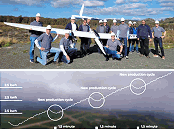 "Norwegian Wind Energy developer Kitemill
has secured more than €2m of funding from Dutch investment entity Expanding Dreams.
KiteMill secures E2m for wind energy 'Together with smaller investors and a tax
relief grant, the combined package will cover the majority of planned activity for
2024,' according to the company. The company's technology
generates power using a tethered glider, which initially launches
itself using a small motor-driven propeller. When aloft, the glider pulls against
its tether, unwinding it from a drum, whose rotation generates electrical power.
Once at its furthest extent, the glider drops towards the drum, allowing the tether
to be re-wound with little effort, after which the pull-rewind cycle repeats until
the wind stops. Flying certain patterns allows the aircraft to maximize the energy
generated during pulling, and the system spends 90% of its time generating power
and 10% rewinding the tether, according to the company. 'With this influx of resources,
we aim to expedite the development of our current model, KM1, and the forthcoming
KM2. These models represent significant advancements in harnessing high-altitude
wind..." "Norwegian Wind Energy developer Kitemill
has secured more than €2m of funding from Dutch investment entity Expanding Dreams.
KiteMill secures E2m for wind energy 'Together with smaller investors and a tax
relief grant, the combined package will cover the majority of planned activity for
2024,' according to the company. The company's technology
generates power using a tethered glider, which initially launches
itself using a small motor-driven propeller. When aloft, the glider pulls against
its tether, unwinding it from a drum, whose rotation generates electrical power.
Once at its furthest extent, the glider drops towards the drum, allowing the tether
to be re-wound with little effort, after which the pull-rewind cycle repeats until
the wind stops. Flying certain patterns allows the aircraft to maximize the energy
generated during pulling, and the system spends 90% of its time generating power
and 10% rewinding the tether, according to the company. 'With this influx of resources,
we aim to expedite the development of our current model, KM1, and the forthcoming
KM2. These models represent significant advancements in harnessing high-altitude
wind..."
 Just as originally intended, a lot of people
have contacted me after seeing themselves, a friend, or a family member mentioned
in one of these articles published in vintage American Modeler and
American Aircraft Modeler magazines. Often, it came as the result of reporting
on a modeling event, like the "Mid-America
Stunt Championships" covered here in "Wild Bill Netzeband's Control Line Capers"
column in the January / February 1963 issue of American Modeler magazine. Do a site-wide
search of Airplanes and Rockets to see if your name appears somewhere. Also in the
article is a report of Veco's new 35C and also on a game-changing monoline control
handle for C/L racing. A comical "Things You Wouldn't Know" section is included
to provide the "real" meaning of words used by modelers. Did you know that Bob Violett
and Cliff Telford of R/C racing fame did C/L racing as well? Just as originally intended, a lot of people
have contacted me after seeing themselves, a friend, or a family member mentioned
in one of these articles published in vintage American Modeler and
American Aircraft Modeler magazines. Often, it came as the result of reporting
on a modeling event, like the "Mid-America
Stunt Championships" covered here in "Wild Bill Netzeband's Control Line Capers"
column in the January / February 1963 issue of American Modeler magazine. Do a site-wide
search of Airplanes and Rockets to see if your name appears somewhere. Also in the
article is a report of Veco's new 35C and also on a game-changing monoline control
handle for C/L racing. A comical "Things You Wouldn't Know" section is included
to provide the "real" meaning of words used by modelers. Did you know that Bob Violett
and Cliff Telford of R/C racing fame did C/L racing as well?
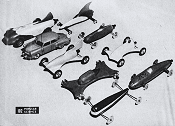 I don't know what aircraft engineers do
during their lunch hour these days, but back in 1947 when this article appeared
in Popular Science magazine, some of them raced
CO2-powered model cars. They're a sort of Cub Scout
Pinewood Derby cars on steroids. Split into light and heavy classes (7/8 ounce to
4-1/4 ounces), these aerodynamically shaped crates were carved from balsa blocks
and rolled on metal or rubber wheels along a 240-foot string. It was the dawn of
the jet age, so building competitive jet-powered models was a natural extension
of the work many of them did as avocation / profession. I'm guessing there is more
than one Ph.D. in that crowd, but there's a good chance the guy with the fastest
car was a technician. BTW, although the venue at first glance appears to be a row
of cubicles with their occupants leaning over the walls, cubicles were not a "thing"
back in the day. Engineers and draftsmen at large firms typically sat in huge, open
rooms filled with drafting tables and test equipment... I don't know what aircraft engineers do
during their lunch hour these days, but back in 1947 when this article appeared
in Popular Science magazine, some of them raced
CO2-powered model cars. They're a sort of Cub Scout
Pinewood Derby cars on steroids. Split into light and heavy classes (7/8 ounce to
4-1/4 ounces), these aerodynamically shaped crates were carved from balsa blocks
and rolled on metal or rubber wheels along a 240-foot string. It was the dawn of
the jet age, so building competitive jet-powered models was a natural extension
of the work many of them did as avocation / profession. I'm guessing there is more
than one Ph.D. in that crowd, but there's a good chance the guy with the fastest
car was a technician. BTW, although the venue at first glance appears to be a row
of cubicles with their occupants leaning over the walls, cubicles were not a "thing"
back in the day. Engineers and draftsmen at large firms typically sat in huge, open
rooms filled with drafting tables and test equipment...
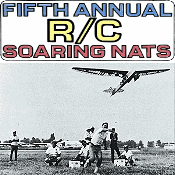 In 1974, I was flying some of my first R/C
gliders - probably a Mark's Models Windward or maybe the Windfree (in that order).
During that time, I tried hard to locate a group of sailplane flyers in my area
around Mayo, Maryland, but to no avail. The nearest R/C flying field was about 30
miles away in Upper Marlboro, MD, where the PGRC club field used to be. My family's
car was held together with chewing gum and bailing wire, so it wasn't often that
I could talk my father into driving me out there, and the few times that he gave
in to my whining, there were never any gliders present. When I would see articles
like this one on the
Fifth Annual R/C Soaring Nats in the October 1974 issue of
American Aircraft Modeler magazine, my envy level would increase significantly
both from the standpoint of way-cool models and R/C equipment (I had second-hand
junk, purchased with newspaper route money), but also because of the people lucky
enough to have access to such venues... In 1974, I was flying some of my first R/C
gliders - probably a Mark's Models Windward or maybe the Windfree (in that order).
During that time, I tried hard to locate a group of sailplane flyers in my area
around Mayo, Maryland, but to no avail. The nearest R/C flying field was about 30
miles away in Upper Marlboro, MD, where the PGRC club field used to be. My family's
car was held together with chewing gum and bailing wire, so it wasn't often that
I could talk my father into driving me out there, and the few times that he gave
in to my whining, there were never any gliders present. When I would see articles
like this one on the
Fifth Annual R/C Soaring Nats in the October 1974 issue of
American Aircraft Modeler magazine, my envy level would increase significantly
both from the standpoint of way-cool models and R/C equipment (I had second-hand
junk, purchased with newspaper route money), but also because of the people lucky
enough to have access to such venues...
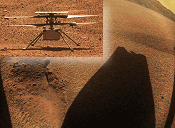 "The
Ingenuity Mars Helicopter made its 72nd and final flight on 18
January. 'While the helicopter remains upright and in communication with ground
controllers,' NASA's Jet Propulsion Lab said in a press release this afternoon,
'imagery of its Jan. 18 flight sent to Earth this week indicates one or more of
its rotor blades sustained damage during landing, and it is no longer capable of
flight.' That's what you're seeing in the picture above: the shadow of a broken
tip of one of the helicopter's four two-foot long carbon fiber rotor blades. NASA
is assuming that at least one blade struck the Martian surface during a 'rough landing,'
and this is not the kind of damage that will allow the helicopter to get back into
the air. Ingenuity's mission is over. NASA held a press conference earlier this
evening to give as much information as they can about exactly what happened to Ingenuity,
and what comes next. First, here's a summary from the press release: Ingenuity's
team planned for the helicopter to make a short vertical flight..." "The
Ingenuity Mars Helicopter made its 72nd and final flight on 18
January. 'While the helicopter remains upright and in communication with ground
controllers,' NASA's Jet Propulsion Lab said in a press release this afternoon,
'imagery of its Jan. 18 flight sent to Earth this week indicates one or more of
its rotor blades sustained damage during landing, and it is no longer capable of
flight.' That's what you're seeing in the picture above: the shadow of a broken
tip of one of the helicopter's four two-foot long carbon fiber rotor blades. NASA
is assuming that at least one blade struck the Martian surface during a 'rough landing,'
and this is not the kind of damage that will allow the helicopter to get back into
the air. Ingenuity's mission is over. NASA held a press conference earlier this
evening to give as much information as they can about exactly what happened to Ingenuity,
and what comes next. First, here's a summary from the press release: Ingenuity's
team planned for the helicopter to make a short vertical flight..."
 S.C. Smith's cover drawing for this
1956 issue of Air Trails magazine is an enhanced version of Wayne Schindler's
ducted fan Saab Draken 210 free flight [semi] scale model airplane.
Back in the day, there were no commercially available ducted fan units, so they
needed to be designed and fabricated by the builder of the model. The computer optimized
ducted fan units we have today are matched to the powerplant, which much more often
that not is a brushless motor. I don't know if anyone makes a ducted fan for glow
fuel engines anymore. This Saab Draken 210 used a Cox .049 Thermal Hopper glow engine,
which was capable of turning 10,000 rpm. 1956 is the year Cox introduced the
Babe Bee .049 was introduced, but might not have been available at the time. It
could do 13,500 rpm on 15% nitro fuel, so could have added significant thrust
to the ducted fan unit. The six-blade, three-inch diameter fan was not enclosed
in a tightly fitting duct like modern fans are. This new 50 mm diameter (~2")
electric ducted fan (EDF) puts out 770 g (1.6 lb.) of thrust on a 3-cell
LiPo battery... S.C. Smith's cover drawing for this
1956 issue of Air Trails magazine is an enhanced version of Wayne Schindler's
ducted fan Saab Draken 210 free flight [semi] scale model airplane.
Back in the day, there were no commercially available ducted fan units, so they
needed to be designed and fabricated by the builder of the model. The computer optimized
ducted fan units we have today are matched to the powerplant, which much more often
that not is a brushless motor. I don't know if anyone makes a ducted fan for glow
fuel engines anymore. This Saab Draken 210 used a Cox .049 Thermal Hopper glow engine,
which was capable of turning 10,000 rpm. 1956 is the year Cox introduced the
Babe Bee .049 was introduced, but might not have been available at the time. It
could do 13,500 rpm on 15% nitro fuel, so could have added significant thrust
to the ducted fan unit. The six-blade, three-inch diameter fan was not enclosed
in a tightly fitting duct like modern fans are. This new 50 mm diameter (~2")
electric ducted fan (EDF) puts out 770 g (1.6 lb.) of thrust on a 3-cell
LiPo battery...
 Ah, the simpler times when enjoyment, competition,
and industry could be found on a
slot car race track in a musty basement. Pre-fab models were rare
in the day, and those that could be bought couldn't hold a candle to those hand
crafted by young men like the ones in these photos. It was not a pastime only for
the younger set, though. Older guys with metal lathes and fine crafting tools created
museum quality masterpieces. This "International Miniature Racing" article from
the August 1962 issue of American Modeler magazine reports on worldwide
interest in slot car racing. I'm always amazed at how many men and boys wore sport
coats and ties while participating not just in formal events, but even during everyday
activities... Ah, the simpler times when enjoyment, competition,
and industry could be found on a
slot car race track in a musty basement. Pre-fab models were rare
in the day, and those that could be bought couldn't hold a candle to those hand
crafted by young men like the ones in these photos. It was not a pastime only for
the younger set, though. Older guys with metal lathes and fine crafting tools created
museum quality masterpieces. This "International Miniature Racing" article from
the August 1962 issue of American Modeler magazine reports on worldwide
interest in slot car racing. I'm always amazed at how many men and boys wore sport
coats and ties while participating not just in formal events, but even during everyday
activities...
 Airplanes and Rockets visitor Dave J. wrote
to ask that I post this article on the
Missy DARA
(Dayton Air Racing Association ) quarter midget racer that appeared in the April
1974 edition of American Aircraft Modeler magazine. It is a scale knockoff of the
full-scale Miss Dara Formula racer. I offer to do this for people at no charge as
time permits. Also, I usually post a scan of the plans, but if you are going to
build the model, I highly recommend buying a set from the AMA Plans Service if they
are still available. Missy Dara plans do not appear to be available at this time.
The AMA will scale the plans to any size you need, so you're not locked into the
original wingspan. House of Balsa manufactured a Miss Dara kit back in the 1980s... Airplanes and Rockets visitor Dave J. wrote
to ask that I post this article on the
Missy DARA
(Dayton Air Racing Association ) quarter midget racer that appeared in the April
1974 edition of American Aircraft Modeler magazine. It is a scale knockoff of the
full-scale Miss Dara Formula racer. I offer to do this for people at no charge as
time permits. Also, I usually post a scan of the plans, but if you are going to
build the model, I highly recommend buying a set from the AMA Plans Service if they
are still available. Missy Dara plans do not appear to be available at this time.
The AMA will scale the plans to any size you need, so you're not locked into the
original wingspan. House of Balsa manufactured a Miss Dara kit back in the 1980s...
 G. Harry Stine was (and in some places
still is) a household word (ok, a letter and two words) amongst people who engage
in model rocketry. As a degreed physicist, he spent his professional years working
in both civilian and government aerospace projects. In his spare time, Mr. Stine
contributed mightily to the science, industry, and sport of model rocketry. His
monthly columns in American Aircraft Modeler magazine were read and appreciated
by enthusiasts hungry for a regular helping of the technical side of the craft,
served in layman's terms. A typical article written by him reports on some happenings
in the trade show and contest realms, while including a lesson in
model rocket design and flight... G. Harry Stine was (and in some places
still is) a household word (ok, a letter and two words) amongst people who engage
in model rocketry. As a degreed physicist, he spent his professional years working
in both civilian and government aerospace projects. In his spare time, Mr. Stine
contributed mightily to the science, industry, and sport of model rocketry. His
monthly columns in American Aircraft Modeler magazine were read and appreciated
by enthusiasts hungry for a regular helping of the technical side of the craft,
served in layman's terms. A typical article written by him reports on some happenings
in the trade show and contest realms, while including a lesson in
model rocket design and flight...
|



